Curtiss-Wright SB2C Helldiver Videos
|
Loading...
|
|
On the "Lafayette"?
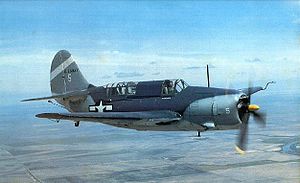
Picture - Curtiss SB2C Helldiver
Role: Dive bomber
National origin: United States
Manufacturer: Curtiss-Wright
Fairchild (Canada) (SBF)
Canadian Car & Foundry (SBW)
First flight: 18 December 1940
Introduced: 11 November 1943
Retired: 1959 (Italian Air Force)
Primary users: United States Navy
United States Army Air Forces
French Air Force
Royal Thai Air Force
Produced: 1943-1945
Number built: 7,140
Developed into: XSB3C
The Curtiss SB2C Helldiver was a carrier-based dive bomber aircraft produced for the United States Navy during World War II. It replaced the Douglas SBD Dauntless in US Navy service. Despite its size, the SB2C was much faster than the SBD it replaced. Crew nicknames for the aircraft included the Big-Tailed Beast (or just the derogatory Beast), Two-Cee and Son-of-a-Bitch 2nd Class (after its designation and partly because of its reputation for having difficult handling characteristics).
Although production problems persisted throughout its combat service, pilots soon changed their minds about the potency of the Helldiver.
Delays marred its production. Built for the USAAF as the A-25 Shrike, by the time it was delivered it was no longer required. Substantial orders by the British Royal Navy and the Royal Australian Air Force were both cancelled due to the poor handling of the aircraft.
Design and development
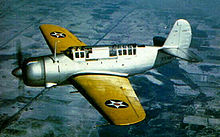
Picture - Curtiss XSB2C Helldiver prototype on its maiden flight
The Helldiver was developed to replace the Douglas SBD Dauntless; it was a much larger aircraft able to operate from the latest aircraft carriers of the time and carry a considerable array of armament and featured an internal bomb bay that reduced drag when carrying heavy ordnance. Saddled with demanding requirements set forth by both the U.S. Marines and United States Army Air Forces, the manufacturer incorporated features of a "multi-role" aircraft into the design.
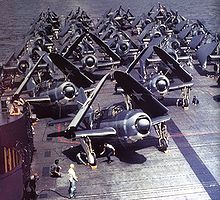
Picture - SB2Cs in tricolor scheme (front) on the flight deck of USS Yorktown in 1943.
The Model XSB2C-1 prototype initially suffered teething problems connected to its R-2600 engine and 3-bladed propeller; further concerns included structural weaknesses, poor handling, directional instability and bad stall characteristics. The first prototype flew in December 1940. After the prototype crashed in February 1941, Curtiss was asked to rebuild it with revised structures and shapes. This second prototype version was also lost when in December 1941 the Helldiver pulled out of a dive and the starboard wing and tailplane failed catastrophically.
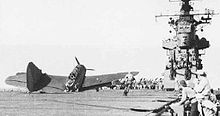
Picture - VB-17 SB2C-1 which lost its tail while landing on USS Bunker Hill in 1943.
Large-scale production had already been ordered on 29 November 1940, but a large number of modifications were specified for the production model. The size of the fin and rudder was enlarged, fuel capacity was increased, self-sealing fuel tanks added and the fixed armament was doubled to four 0.50 in (12.7 mm) machine guns in the wings, compared with the prototype's two cowling guns. The SB2C-2 was built with larger fuel tanks, improving its range considerably.
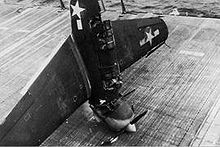
Picture - An SB2C Helldiver failed to catch the wire on landing and hit the first barrier, nose-diving into the deck (USS Hornet, 3 July 1944).
The program suffered so many delays that the Grumman TBF Avenger entered service before the Helldiver, even though the Avenger had begun its development two years later. Nevertheless, production tempo accelerated with production at Columbus, Ohio and two Canadian factories: Fairchild Aircraft Ltd. (Canada) which produced a total of 300 (under the designations XSBF-l, SBF-l, SBF-3 and SBF-4E) and Canadian Car and Foundry which built 894 (designated SBW-l, SBW-3, SBW-4, SBW-4E and SBW-5), these models being respectively equivalent to their Curtiss-built counterparts. A total of 7,140 SB2Cs were produced in World War II.
Operational history
The U.S. Navy would not accept the SB2C until 880 modifications to the design and the changes on the production line had been made, delaying the Curtiss Helldiver's combat debut until 11 November 1943 with squadron VB-17 on the USS Bunker Hill, when they attacked the Japanese-held port of Rabaul on the island of New Britain, north of Papua New Guinea. Even though the Helldiver had entered U.S. Navy service, it still had such structural problems that the aircraft crews were forbidden to dive bomb (one of its main tasks) in clean configuration. The SB2C-1 could deploy slats mechanically linked with undercarriage actuation extended from the outer third of the wing leading edge to aid lateral control at low speeds. The early prognosis of the "Beast" was unfavourable as it was strongly disliked by aircrews because it was much bigger and heavier than the SBD it replaced.
In the first Battle of the Philippine Sea, 45 Helldivers were lost because they ran out of fuel on the return to their carriers.
The litany of faults that the Helldiver bore included the fact that it was underpowered, had a shorter range than the SBD, was equipped with an unreliable electrical system and was often poorly manufactured. The Curtis-Electric propeller and the complex hydraulic system had frequent maintenance problems.
The problems were largely solved by the time the SB2C-4 made its appearance. The aircrew eventually began to appreciate the aircraft's ability to keep up with escort fighters, to easily carry a heavier bomb load, and to sortie over a longer distance. The Helldivers would participate in battles over Marianas, Leyte (partly responsible for sinking the Musashi), Taiwan, and Okinawa (in the sinking of the Yamato).
An oddity of the SB2Cs with 1942 to 1943-style tricolor camouflage was that the undersides of the outer wing panels carried dark topside camouflage because the undersurfaces were visible from above when the wings were folded.
In operational experience it was found that the U.S. Navy's F6F and F4U fighters were able to carry just as heavy a bomb load and were far more able to take care of themselves against enemy fighters once their offensive armament had been discharged. The advent of air to ground rockets allowed the attack of ship and shore based targets without the stress and hence weight/performance issues that dive bombers had to endure. All this meant that the SB2C was the last purpose built dive bomber.
Postwar, surplus aircraft were sold to the navies of France, Italy, Greece, Portugal and Thailand.
Army service
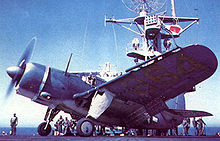
Picture - Curtiss SB2C Helldiver during takeoff.
Built at Curtiss' St. Louis plant, 900 aircraft were ordered by the USAAF under the designation A-25A Shrike. The first 10 aircraft had folding wings, while the remainder of the production order deleted this unneeded feature. Many other changes distinguished the A-25A including larger main wheels, a pneumatic tail wheel, ring and bead gunsight, longer exhaust stubs and other Army specified radio equipment. By later 1943 when the A-25A was being introduced, the USAAF no longer had a role for the dive bomber. After offering the Shrike to Australia, only 10 were accepted before the Royal Australian Air Force rejected the remainder of the order, forcing the USAAF to send 410 to the U.S. Marines. The A-25As were converted to SB2C-1 standard but the Marine SB2C-1 variant never saw combat, being used primarily as trainers. The remaining A-25As were similarly employed as trainers and target tugs.
British service
A comparable scenario accompanied the Helldiver's service with the British. A total of 26 aircraft, out of 450 ordered, were delivered to the Royal Navy's Fleet Air Arm, where they were known as the Helldiver I. After unsatisfactory tests that pinpointed "appalling handling", none of the British Helldivers were used in action.
Variants
XSB2C-1 Prototype powered by a 1,700 hp (1,268 kW) R-2600-8 engine SB2C-1 Production version for United States Navy with four 0.50 in (12.7 mm) wing guns and one 0.30 in (7.62 mm) dorsal gun, 200 built. SB2C-1A Original designation for United States Army Air Corps version which became A-25A later used for 410 A-25As transferred to the United States Marine Corps. SB2C-1C SB2C-1 with two 20 mm (0.79 in) wing-mounted cannons and hydraulically operated flaps, 778 built. XSB2C-2 One SB2C-1 fitted with twin floats in 1942. SB2C-2 Production float plane version, 287 cancelled and not built. XSB2C-3 One SB2C-1 re-engined with a 1,900 hp (1,417 kW) R-2600-20. SB2C-3 As SB2C-1 re-engined with a 1,900 hp (1,417 kW) R-2600-20 and four-bladed propeller, 1,112 built. S2BC-3E SB2C-3s fitted with APS-4 radar. SB2C-4 SB2C-1 but fitted with wing racks for eight 5 in (127 mm) rockets or 1,000 lb (454 kg) bombs, 2,045 built. SB2C-4E SB2C-4s fitted with APS-4 radar. XSB2C-5 Two SB2C-4s converted as prototypes for -5 variant. SB2C-5 SB2C-4 with increased fuel capacity, 970 built (2,500 cancelled) XSB2C-6 Two SB2C-1Cs fitted with 2,100 hp (1,566 kW) R-2600-22 engine and increased fuel capacity. SBF-1 Canadian built version of the SB2C-1, 50 built by Fairchild-Canada SBF-3 Canadian built version of the SB2C-3, 150 built by Fairchild-Canada. SBF-4E Canadian built version of the SB2C-4E, 100 built by Fairchild-Canada. SBW-1 Canadian built version of the SB2C-1, 38 built by Canadian Car & Foundry company. SBW-1B Canadian built version for lend-lease to the Royal Navy as the Helldiver I, 28 aircraft built by Canadian Car & Foundry company. SBW-3 Canadian built version of the SB2C-3, 413 built by Canadian Car & Foundry company. SBW-4E Canadian built version of the SB2C-4E, 270 built by Canadian Car & Foundry company.
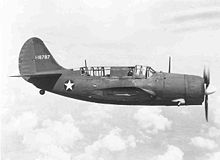
Picture - U.S. Army Air Force A-25 Shrike in flight.
SBW-5 Canadian-built version of the SB2C-5, 85 built (165 cancelled) by the Canadian Car & Foundry company. A-25A Shrike United States Army Air Corps version without arrester gear or folding wings and equipment changed, 900 built Helldiver I Royal Navy designation for 28 Canadian-built SBW-1Bs
Operators
Australia
Royal Australian Air Force
France
French Navy Aviation Navale
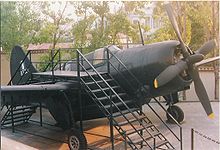
Picture - A preserved Greek SB2C-4.
Greece
Royal Hellenic Air Force
Italy
Aeronautica Militare
Portugal
Portuguese Navy (until 1952)
Portuguese Air Force (after 1952)

Picture - Delivery of an SB2C-5 to Thailand in 1951.
Thailand
Royal Thai Air Force
United Kingdom
Royal Navy Fleet Air Arm
United States
United States Army Air Forces
United States Marine Corps
United States Navy
Accidents and incidents
On 25 March 2010, the Oregon State Police, Tillamook County Sheriff's Office and the United Sates Navy announced that during a logging operation near Rockaway Beach, Oregon, the wreck of an SB2C Helldiver was located. Initial responders believe there are possible human remains at the scene.
An SB2C-1C Helldiver that was ditched in Maalaea Bay off South Maui in August 1944 was discovered in January 2010 by Brad Varney, owner of B&B Scuba. The Helldiver is covered in coral and is missing its tail section. The aircraft experienced problems with its empennage after dive bombing maneuvers which forced pilot Lieutenant William Dill to ditch in Maalaea Bay. It lies in 50 ft of water facing east. The site, which is protected under state and federal law, is in the process of being marked with a plaque by the US Navy. A mooring may be installed at a later point in time to facilitate dives on the site.
Survivors
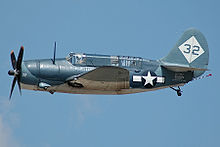
Picture - Curtiss SB2C Helldiver (Commemorative Air Force)
One SB2C Helldiver is still flying. Owned by the Commemorative Air Force, this late-production SB2C-5 (BuNo. 83589) built in 1945 is based in Graham, Texas and makes frequent air show appearances. In 1982, it experienced engine failure and a hard emergency landing that caused extensive damage; volunteers of the CAF put in thousands of hours and spent in excess of $200,000 to restore the aircraft to flying condition once more.
Other surviving airframes include
A-25A "Shrike" (s/n 42-80449) is located at the National Museum of the United States Air Force in Dayton, Ohio.
SB2C-5, BuNo. 83479 at the National Air and Space Museum
SB2C-3, BuNo. 19075 at the Yanks Air Museum, Chino, California
SB2C-5, BuNo. 83321 at the Hellenic Air Force Museum, Decelea Air Base, Greece
SB2C-5, BuNo. 83410 at the Royal Thai Air Force Museum, Don Muang AB, Bangkok
SB2C-4, BuNo. 19866 submerged in Lower Otay Reservoir, San Diego, California may soon be salvaged.
Specifications (SB2C Helldiver)
Data from
General characteristics
Crew: Two, pilot and radio operator/gunner
Length: 36 ft 9 in (11.2 m)
Wingspan: 49 ft 9 in (15.2 m)
Height: 14 ft 9 in (4.5 m)
Wing area: 422 ft² (39.2 m²)
Empty weight: 10,114 lb (4,588 kg)
Loaded weight: 13,674 lb (6,202 kg)
Max takeoff weight: 16,800 lb (7,600 kg)
Powerplant: 1x— Wright R-2600 Cyclone radial engine, 1,900 hp (1,400 kW)
Performance
Maximum speed: 294 mph (473 km/h)
Range: 1,200 miles (1,900 km)
Service ceiling: 25,000 ft (7,600 m)
Rate of climb: 1,750 ft/min (8.9 m/s)
Armament
Guns:
2 x— 20 mm (.79 in) cannon in the wings
2 x— 0.30 in (7.62 mm) M1919 Browning machine guns in the rear cockpit
Bombs: in internal bay: 2,000 lb (900 kg) of bombs or 1 x— Mark 13-2 torpedo
on underwing hardpoints: 500 lb (225 kg) of bombs each
Related development
Curtiss XBT2C
Comparable aircraft
Aichi D3A
Breda Ba.65
SBD Dauntless
Fairey Barracuda
Junkers Ju 87 Stuka
SB2A Buccaneer
A-31 Vengeance
Bibliography
Andrews, Harald. The Curtiss SB2C-1 Helldiver, Aircraft in Profile 124. Windsor, Berkshire, UK: Profile publications Ltd., 1967, reprinted 1971 and 1982. No ISBN.
Bowers, Peter M. Curtiss Aircraft 1907-1947. London: Putnam & Company Ltd., 1979. ISBN 0-370-10029-8.
Brown, Eric, CBE, DCS, AFC, RN.; Green William and Swanborough, Gordon. "Curtiss Helldiver". Wings of the Navy, Flying Allied Carrier Aircraft of World War Two. London: Jane's Publishing Company, 1980, p. 90-99. ISBN 0-7106-0002-X.
Crosnier, Alain and Jean-Pierre Dubois. Douglas SBD-5 Dauntless & Curtiss SB2C-5 Helldiver: Bombardiers en piqué de l’Aéronautique Navale (in French). Clichy-la-Garenne, France: DTU sarl., 1998. ISBN 2-912749-01-8.
Drendel, Lou. U.S. Navy Carrier Bombers of World War II. Carrollton, TX: Squadron/Signal Publications, Inc., 1987. ISBN 0-89747-195-4.
Forsyth, John F. Helldivers, US Navy Dive-Bombers at War. St. Paul, Minnesota: Motorbooks International, 1991. ISBN 0-87938-493-X.
Kinzey, Bert. SB2C Helldiver in Detail & Scale, D&S Vol.52. Carrollton, Texas: Squadron/Signal Publications, 1997. ISBN 1-888974-04-4.
Ociepka, Paweł P. "Curtiss SB2C Helldiver" Skrzydła w miniaturze 12. Gdańsk, Poland: Avia-Press, 1995. ISSN 1234-4109.
Shettle, M.L. Jr. United States Marine Corps Air Stations of World War II. Bowersville, Georgia: Schaertel Publishing Co., 2001. ISBN 0-964-33882-3.
Smith, Peter C. SB2C Helldiver. Ramsbury, Marlborough, Wiltshire: The Crowood Press Ltd., 1998. ISBN 1-86126-710-X.
Stern, Robert. SB2C Helldiver in Action, Aircraft Number 54. Carrollton, Texas: Squadron/Signal Publications inc., 1982. ISBN 0-89747-128-8.
Taylor, John W. R. "Curtiss SB2C/A-25 Helldiver." Combat Aircraft of the World from 1909 to the present. New York: G.P. Putnam's Sons, 1969. ISBN 0-425-03633-2.
Tillman, Barrett. Helldiver Units of World War 2. London: Osprey Publishing, 1997. ISBN 1-85532-689-2.
Tillman, Barrett and Robert L. Lawson. U.S. Navy Dive and Torpedo Bombers of WWII. St. Paul, Minnesota: Motor Books Publishing, 2001. ISBN 0-7603-0959-0.
Winchester, Jim. "Curtiss SB2C Helldiver." Aircraft of World War II: The Aviation Factfile. Kent, UK: Grange Books plc, 2004. ISBN 1-84013-639-1.
Living Warbirds: The best warbirds DVD series.
Source: WikiPedia